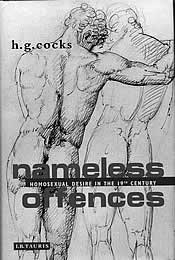

Issue 14 . Winter 2003
Charity, Hilarity, Pride Events, Remembrance? . From the Bookshelf . Zena Remembered . 1973: Naughty Schoolboys and Cottaging Crackdown . Make Life Beautiful! . Lord Alfred Douglas . Thank-you One and All
 From
the Bookshelf
From
the Bookshelf
British gay history, eh? You wait for years for something decent to read and then five books arrive all at once. Graham Robb’s Strangers: Homosexual Love in the Nineteenth Century is a popular assemblage of material from across Europe and America, much of which will be familiar to serious students of the field, who might find H. G. Cocks’ Nameless Offences: Homosexual Desire in the 19th Century more rewarding in its focus on fresh British archival findings, particularly court proceedings and newspaper reports.
Like the Cocks book, Matt Cook’s London and the Culture of Homosexuality, 1885-1914 is a profitably reworked Ph.D dissertation and many of his conclusions will also be true of gay life in Brighton, very much then as now London’s sister metropolis. Mark W. Turner provides a lighter read with his history, Backward Glances: Cruising the Queer Streets of New York and London, also casting valuable light on Brighton's hallowed seafront haunts.
Halifax church
One of the great pioneers of British gay history, Alan Bray’s posthumous work, The Friend, is a subtly argued exploration of the religious meaning of same-sex friendships in medieval and early modern England, including the partnerships described by Anne Lister in her voluminously lesbian diaries. Bray also records the recent discovery of two fragments of Lister’s tombstone in the parish church at Halifax, broken and hidden for many years under the late-Victorian flagstones. Fans of Lister will enjoy Jill Liddington’s latest slice of the diaries, Nature’s Domain: Anne Lister and the Landscape of Desire, which opens with an account of a failed romance in Hastings in 1832 when she “cried & sobbed bitterly for an hour last night”. How long can it be before an academic press bankrolls a complete edition of the Lister diaries? At four million words, they are nearly four times the length of the diary of Samuel Pepys but the benefit to our understanding of lesbian history would be immeasurable.
Lastly, Caroline Zilboorg’s The Masks of Mary Renault: A Literary Biography, records a Sussex summer holiday of 1937 when Renault and her partner Julie Mullard rented a tiny cottage near Horsted Keynes, living together for the first time in what proved to be a 50-year relationship. The pair cycled around the countryside, took “our clothes off in the fields” and devoted domestic hours to cooking and work on Renault’s debut novel, Purposes of Love, the nearest she came to lesbian fiction in a body of work devoted largely to male homosexuality.
If you'd like to look at these books at the archive email info@brightonourstory.co.uk.
Tom
Back to top of page
Back to Ourstory home page